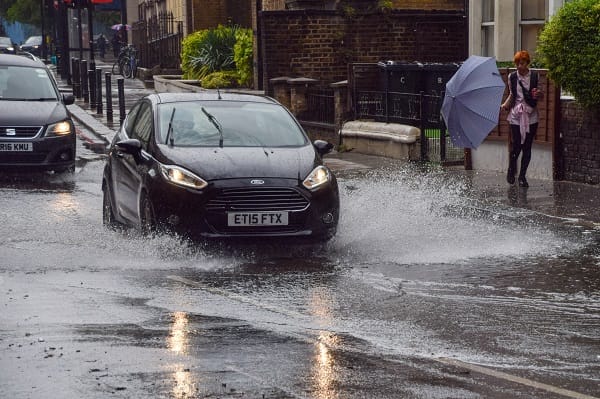As Storm Agnes is set to begin this storm naming season by bringing gales of up to 75mph to many parts of the UK, leading rural insurer is urging home and business owners to act now to make their properties storm resilient.
Storm Agnes has hit today and will last until Thursday and is the first storm of this storm naming season, which began on 1 September and will run until 31 August 2024.
The Met Office predicts it will bring damaging winds of up to 75mph in many parts of the UK and could cause gales of 80mph in more exposed areas.
Gusts of 75mph could be strong enough to damage roofs or topple weak walls, and loose branches and furniture could be thrown around, causing a danger to people and property, while heavy rain in Scotland could lead to localised flooding.
Jon Bird, Property Claims Manager at NFU Mutual, is urging all home and business owners to act now to try and mitigate damage and disruption.
Bird said, “With the storm season starting and more storms likely to hit between now and the end of winter, this is the perfect time to fortify your property or business against storms and minimise any disruption in the next few months.
“NFU Mutual has responded to this first storm of the season by placing its network of Agency offices across the UK on alert and preparing call handlers and loss adjusters for an increase in claims.
“While we stand ready to assist customers who suffer damage in Storm Agnes, we also urge home and business owners to check now whether their property is storm resilient.
“As the leading rural insurer, we know that isolated properties, along with those on the coast, are most at risk from windstorms like Storm Agnes. Owners of such properties should pay particular attention to storm resilience measures.”
NFU Mutual has provided a handy guide for property owners on how they can secure their property during a storm, including taking simple measures such as securing or storing garden furniture, moving vehicles away from weak walls or trees where possible, and moving possessions away from ground-level rooms if flood warnings are in place.
Road safety
High-speed winds and heavy rain can also make driving significantly more difficult. If motorists need to drive during the storm, they should take measures to minimise the risk, including reducing speeds, leaving greater stopping distances and checking routes for obstructions ahead of time – as well as being aware of dangerous crosswinds.
As well as exposed motorways, high-speed rural A and B Roads, which are deadlier than urban roads in all conditions, pose a significant risk to motorists. Heavy rain and wind can alter visibility and stopping distances, increasing the everyday dangers of rural roads like blind bends and junctions, tight corners, and mud and debris.
As a campaigner for rural road safety, NFU Mutual urges road users driving in stormy conditions to take things slowly, be patient and make sure extreme weather doesn’t result in the tragic loss of life on rural roads.
NFU Mutual’s storm resilience guide
- Make sure all doors and windows can be securely closed.
- Prepare for power cuts: Have torches and batteries to hand and make sure any generators are ready to use if required. If you are using candles, make sure you use them safely and extinguish when leaving the room, and make sure nothing hangs over the candles.
- Inspect your property and make repairs to things like loose fence panels or gates.
- Make sure gutters are not leaking and are clear of leaves and other debris.
- Have a space to put loose outdoor furniture like garden chairs and trampolines. If you do not have an indoor space in which to put them, ensure you have a means of tying down or otherwise securing the furniture.
- Safely check that tiles, slates and roofing sheets are in place, securing any that are not.
- Inspect trees on your property, removing loose or overhanging branches which may cause damage to your or others’ property in a storm.
- Repair or unblock any faulty drains.
- If you have a garage, clear a space for your vehicle in the event of a storm. If you do not have a garage, plan where you can park vehicle during a storm – this should be away from any walls, fences or branches which could fall and damage the vehicle.
- Protect and lag water pipes in vulnerable areas and know where the water supply is so that you can turn it off in the event of burst pipes.
- Stay alert for Met Office weather warnings in your area.
- Have your insurer’s emergency helpline number available.
Additional advice for business owners
- In addition to the above, business owners can:
- Ensure you have emergency contact details for employees to maintain contact during an extreme weather event.
- If you have company vehicles, make sure these are parked away from walls, fences or branches which could damage the vehicles.
- Make sure outdoor signage or displays can be secured or brought inside.
- Ensure you have adequate signage warning customers of things like wet floors that may be more common during extreme weather.
- Prepare an emergency evacuation route in the event of unexpectedly severe weather.
- Ensure central heating will come on during freezing weather to avoid frozen pipes, and consider procuring sandbags to protect your business in the event of a flood.
- Make sure you have a way of communicating closures with customers.
- Consider transport routes to the business and whether traveling will be safe and practical.
While driving
- Drive slowly and steadily and leave larger gaps between vehicles. Wet conditions can increase stopping distances by ten times.
- In windy weather, leave plenty of room when passing other road users, particularly vulnerable road users like walkers, cyclists and motorcyclists.
- Avoid braking suddenly, slowing down gently before corners and junctions.
- Accelerate slowly, keeping revs low.
- Take care coming up to junctions where road markings may be less visible.






Leave a Comment